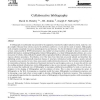Free Online Productivity Tools
i2Speak
i2Symbol
i2OCR
iTex2Img
iWeb2Print
iWeb2Shot
i2Type
iPdf2Split
iPdf2Merge
i2Bopomofo
i2Arabic
i2Style
i2Image
i2PDF
iLatex2Rtf
Sci2ools
IPM
2006
2006
Collaborative bibliography
A bibliography is traditionally characterized by the judgments, bounded by explicit selection criteria, made by a single compiler. Because these criteria concern the attributes ascribed to a work and the needs of readers, bibliographic work is largely conceptual even across technological eras and domains. Yet, the development of networked information services, made possible by WWW infrastructure, has enabled very large numbers of people to discover, organize, and publish information, including bibliographies. Indeed, bibliographies, or at least bibliography-like artifacts, are a common genre of website, often published by people without specialized skills in information organization who follow nonrigorous selection procedures. Nevertheless, even if the items from these lists are poorly selected and described, this publishing activity is fundamentally important because it structures information locally, creating a patchy network of secondary access points. In turn, these access points ...
| Added | 13 Dec 2010 |
| Updated | 13 Dec 2010 |
| Type | Journal |
| Year | 2006 |
| Where | IPM |
| Authors | David G. Hendry, J. R. Jenkins, Joseph F. McCarthy |
Comments (0)

